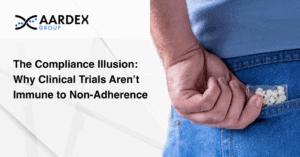In December last year, the Food and Drug Administration (FDA) issued new draft guidance (Digital Health Technologies for Remote Data Acquisition in Clinical investigations) on what kinds of devices and software may be used for remote monitoring of clinical trial participants to ensure the data is sufficient to support a product application. The FDA invited feedback from the industry and a result received over 60 comments from Pharma companies, Industry Consortiums, and Vendors.
While the introduction of the draft guidance was timely and widely welcomed, several companies and stakeholders, including AARDEX Group, wrote to the FDA seeking further clarification on some of the text in the guidance and made recommendations for improving the guidance.
Is Smart Packaging Classified as a DHT?
Prior to submitting our comments to the FDA, we took the liberty of reaching out the the FDA to enquire whether they considered Smart Packaging (i.e. Smart Pill Bottles, electronic blister), technologies used to measure and manage adherence to medication during clinical research, to be a DHT. In response, the FDA indicated that it was “likely” that Smart Packaging would be considered a DHT. They referred us to their 2019 guidance: Enrichment Strategies for Clinical Trials to Support Determination of Effectiveness in Human Drugs and Biological Products, the guidance that reinforces the FDA’s support for using Smart Pill Bottles to ensure adherence to medication in trials.
Managing Patient Adherence is Critical in the Era of DCTs
Adherence plays a vital role in clinical research. Poor patient adherence can undermine the value of the trials; for example, by compromising estimates of the benefits and the risks of an investigational product. It has a greater impact than any other factor on reducing variance in clinical endpoints. In addition, given the uptick in the adoption of the Decentralized Clinical Trial (DCT) model, where some or all of the trial-related activities occur at a location separate from the investigator’s location, the concern about medication non-adherence is growing as trials get closer to a real-life situation. Reinforcing the DCT model with electronic packaging and real-time analytics on patients’ medication-taking behaviors provides investigators with the means to rapidly identify patients that need additional support with the dosing regimen or indeed, patients that have discontinued taking the investigational product due to intolerable side effects, for example. We recommended that the guidance should be adapted to encourage the use of smart packaging.
To Some, the Definition of DHTs is too Broad
The eClinical Forum (ECF), a non-commercial network of peers engaged in clinical research, recommended that the FDA include definitions of what products are not considered as DHTs as well as those that are, reasoning that the definition of DHTs is too broad.
Meanwhile, Denali Therapeutics, for example, a pharmaceutical company dedicated to defeating neurodegenerative diseases, indicated that it would like to see the FDA expand its definition of DHT beyond computing platforms, connectivity products, software, and sensors to also include monitors. The company also indicated that the guidance text implies that all acceptable brands/models/versions of DHT and underlying general-purpose platforms need to be pre-specified in the trial protocol. They commented that this would be extremely impractical for multi-year trials and that in a bring your own device (BYOD) setting, would trigger a large number of protocol violations. They propose to clarify that the protocol can either list qualified platforms or specify the process and requirements for qualifying new platforms on an ongoing basis.
Discontinuing the Use of the Term “Subject”
Bayer, a global pharmaceutical company, applauded the FDA for developing and issuing the draft guidance. They noted that they support the recommendations set out in the guidance and that they look forward to continuing to work with the agency to advance the use of innovative technologies in clinical development and enhance the regulatory landscape for digital health technologies. These comments were accompanied by some recommendations to further enrich the guidance such as; discontinuing the use of the term “subject” in favor of “participant”, as well as adding additional language to the introduction section highlighting all of the potential uses of a DHT. In support of this recommendation, they highlighted that data collected from DHTs may be used to support biomarkers, clinical outcome assessment (COA), or an endpoints/surrogate endpoint. Further, the DHTs might be used to evaluate safety, as well as efficacy. Further still, if data from a DHT is used for an endpoint, the endpoint might be exploratory, secondary, or primary. Additionally, Bayer also recommended that a clear note of the existing Good Clinical Practice (GCP) guidance should be added along with emphasis this should be followed, in addition to the recommendations specific to DHTs provided in the draft guidance.
Revised Definition of Remote Data Collection
Janssen Research & Development, LLA, one of the Janssen Pharmaceutical Companies of Johnson & Johnson, also commended the agency for the draft guidance. Janssen noted that they agree with the sentiment of the guidance, but they also had comments for improvement. They reminded the agency that sponsors often use DHTs for both clinic-based assessment and in locations that are distant from the investigator, and for that reason, they encourage the agency to revise the definition of remote data acquisition, as defined in the guidance as “collection of data from locations that are distant from the investigator or trial investigator”, so that the guidance applies to the use of DHTs more broadly, including hybrid scenarios where data may be collected at clinic-based sites (centralized) and remotely (decentralized) within the same study.
Usability of DHTs
The Association of Clinical Research Organizations (ACRO), also welcomed the guidance and stated that it was pleased to see that specific guidance had been developed that covers the elements to be considered for the use of DHT in clinical trials. In the context of the draft guidance, they recommended that the introduction to the guidance document notes the need to ensure that the use of computerized technology in clinical trials does not disadvantage or reduce access to clinical trials for those who are unable or unaccustomed to using the technology. They fear that the use of electronic technology may unintentionally discriminate against people who are not comfortable with, or who cannot use such technology, and this could introduce bias into the clinical trial. They recommend that the guidance should make it clear that alternative methods should be available for participants that fall into those categories.
Diversity in Clinical Trials
EMD Serono called for an emphasis on the role that DHTs can play in increasing access to and diversification of trials by explicitly mentioning the opportunity that DHTs afford community clinics in engaging underserved non-traditional sites that can be more difficult to access. They added, “DHTs present a real opportunity to address trial access, a particularly problematic barrier to reach representative trials as traditional site selection practices generally do not provide care to underserved populations and are often not easily accessible to diverse communities”.



